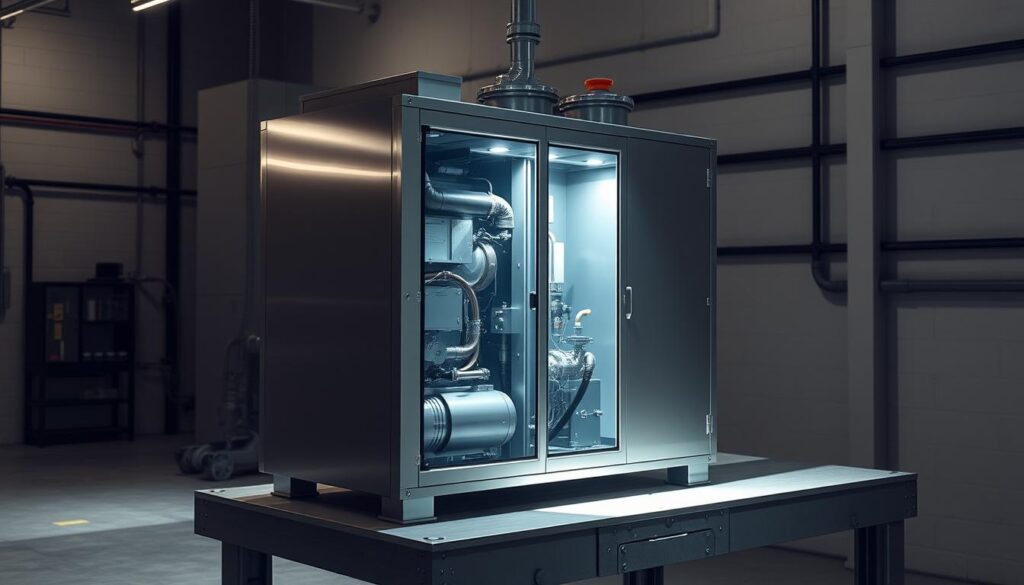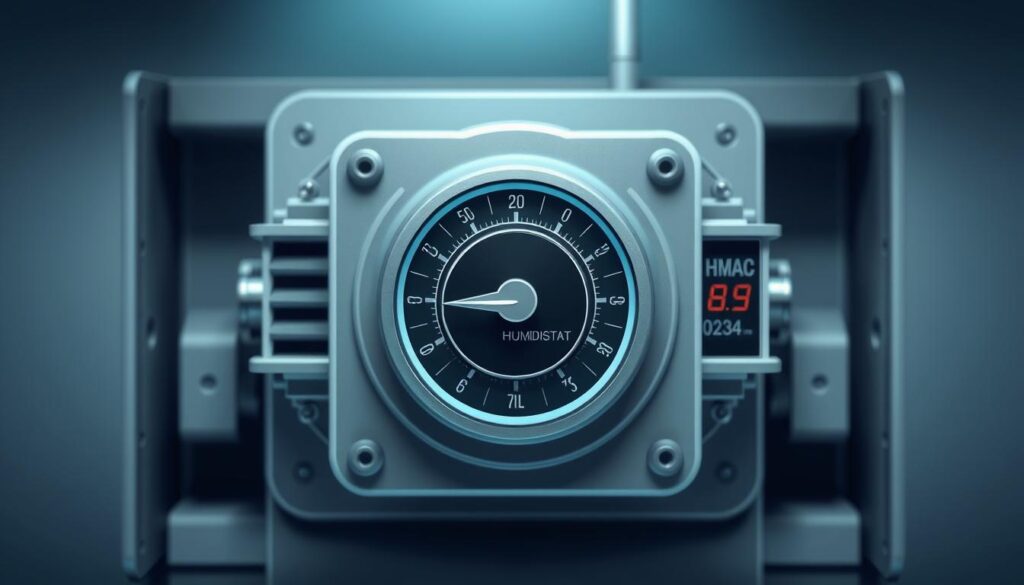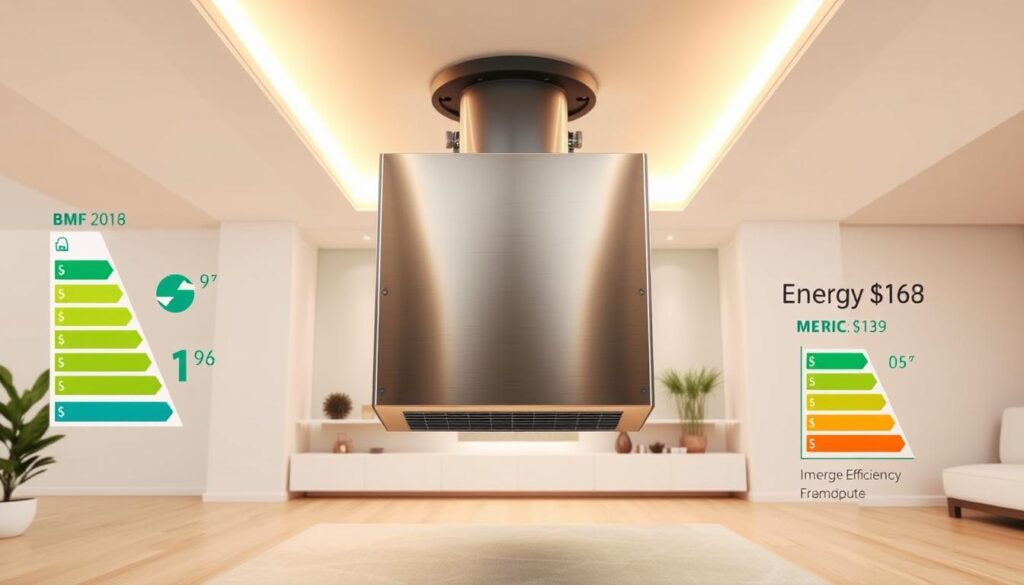Affiliate Disclosure
HVAC Guide Guys is a participant in the Amazon Services LLC Associates Program, an affiliate advertising program designed to provide a means for sites to earn advertising fees by advertising and linking to Amazon.
How HVAC Humidifier Works? Ever felt like your home is too dry in winter? Learning about HVAC humidifiers can change how your home feels.
HVAC humidifiers are key for good indoor air. They add moisture to fight dry skin, static, and breathing problems. They work with your heating and cooling to keep humidity steady.

Whole-house humidifiers are vital in dry winters. They add water vapor to the air, making your home more comfy. They’re good for any size home, helping you manage the air better.
Key Takeaways
- HVAC humidifiers improve overall indoor air quality
- They help prevent dry skin and respiratory issues
- Multiple humidifier units might be needed for larger homes
- Humidity levels should be maintained between 30-50%
- Different humidifier types suit different home configurations
Table of Contents
Understanding the Importance of Home Humidity Control
Indoor air quality is vital for your home’s comfort and health. Keeping humidity levels right is essential. It helps protect your family and property.
Humidity control is more than comfort. It’s a key part of home care that affects your health and home. The best humidity range is between 30% and 50%. This range offers many benefits.
Signs You Need a Whole-House Humidifier
- Persistent dry, itchy skin
- Frequent static electricity
- Cracked wooden floors or furniture
- Increased respiratory discomfort
- Noticeable dust accumulation
Health and Home Benefits of Proper Humidity
Keeping humidity right has big health benefits. Right moisture levels can:
- Reduce respiratory infections
- Prevent dry skin and irritation
- Minimize allergic reactions
- Support better sleep quality
“Controlling indoor humidity is like finding the perfect balance for your home’s ecosystem.” – HVAC Expert
Optimal Humidity Levels for Your Home
Knowing the right humidity levels can change your home. Consistent humidity control protects your home and makes it comfy.
| Humidity Level | Impact |
|---|---|
| Below 30% | Dry, uncomfortable conditions |
| 30-50% | Ideal comfort and health range |
| Above 50% | Risk of mold and moisture damage |
By getting the right humidity control, you’re not just improving air quality. You’re making your home healthier and more comfy.
Explore Our HVAC Shop
Looking for top-rated HVAC tools, parts, and accessories? Visit our shop and find the perfect solution for your needs.
Visit the ShopHow HVAC Humidifier Works in Your Home System
Learning about whole-house humidifiers can make your home more comfortable and the air cleaner. These systems link up with your HVAC, spreading moisture evenly across your home.
The main idea behind HVAC humidifiers is to add moisture to your home’s air. When your furnace runs, the humidifier kicks in. It adds the right amount of water vapor to the air.
“Humidity control is not just about comfort, it’s about creating a healthier indoor environment.”
- Mounted on the furnace’s cold-air return duct
- Connected to the hot-air supply system
- Distributes moisture evenly across all rooms
- Maintains optimal humidity levels between 35-55%
Whole-house humidifiers are different from portable ones. They keep the humidity level right, automatically, all the time. They use your HVAC system to manage moisture, saving energy.
They improve air quality, cut down on static, and might even save you money by letting you set your thermostat lower.
They make your home more comfortable. They also protect your wood furniture and help prevent breathing problems from dry air.
Types of Whole-House Humidifiers Explained
Not all humidifiers are the same. Knowing the different types can help you pick the right one for your home.
There are three main types of whole-house humidifiers. Each has its own features and how well it works:
- Bypass Humidifiers
- Power Humidifiers
- Steam Humidifiers
Bypass Humidifiers: The Basic Solution
Bypass humidifiers are the oldest way to control humidity in homes. They use your heating system to spread moisture. They work by letting warm air from the furnace pass over a water panel, causing moisture to evaporate naturally.
“Bypass humidifiers provide a simple, cost-effective method of adding moisture to your home’s air.”
Power Humidifiers: Enhanced Performance
Power humidifiers are more advanced. They have a fan that helps spread moisture more efficiently. This can add up to 1 gallon more humidity per day than bypass models.
| Humidifier Type | Daily Humidity Output | Energy Consumption |
|---|---|---|
| Bypass Humidifier | 0.5 gallons | Minimal |
| Power Humidifier | 1.5 gallons | 25-watt equivalent |
Steam Humidifiers: Advanced Technology
Steam humidifiers are the most advanced. They boil water to make steam, which is then sent through your HVAC system. They have a high 90% water-to-humidity conversion rate, making them great at keeping humidity levels just right.
When picking a humidifier, think about your home’s size, climate, and moisture needs. This will help you find the best one for your space.
Essential Components of HVAC Humidifiers
Knowing the main parts of your HVAC humidifier is key for keeping it in top shape. It helps improve the air quality inside your home. Each part is important for making your home a comfortable place to be.
The main parts of a whole-house humidifier are:
- Water Reservoir: Holds water for making humidity
- Water Control Valve: Controls how much water flows
- Evaporator Pad: Spreads moisture into the air
- Humidistat: Watches and controls humidity levels
“Proper understanding of your humidifier’s components can significantly enhance your home’s comfort and air quality.”
The water system is key for keeping moisture levels right. Your humidifier’s blower works with these parts to spread moisture all over your home. This makes sure the moisture levels are just right, between 30-50% relative humidity.
| Component | Primary Function | Maintenance Requirement |
|---|---|---|
| Water Reservoir | Water Storage | Annual cleaning |
| Evaporator Pad | Moisture Distribution | Replacement every 6-12 months |
| Humidistat | Humidity Control | Periodic calibration |
Keeping these parts in good shape is important. It makes sure your humidifier works well and doesn’t cause problems like mold. By knowing how each part works, you can keep your home’s humidity just right.
Explore Our HVAC Shop
Looking for top-rated HVAC tools, parts, and accessories? Visit our shop and find the perfect solution for your needs.
Visit the ShopWater Distribution and Evaporation Process
Understanding how water moves and evaporates in HVAC humidifiers is key to controlling humidity at home. These systems help keep the air inside your home just right for comfort and health.
Water Supply Systems
Evaporative humidifiers use your home’s cold-water line. They control water flow with special parts:
- Water inlet orifice
- Inlet valve assembly
- Electric solenoid valve
Evaporator Pad Function
The evaporator pad is vital for controlling humidity. It spreads water evenly and absorbs moisture well. Its design lets water cover more area, helping it evaporate faster.
| Evaporator Pad Characteristics | Performance Impact |
|---|---|
| High surface area | Enhanced moisture absorption |
| Uniform water distribution | Consistent humidity levels |
| Periodic replacement | Maintains system efficiency |
Drainage Systems
Today’s evaporative humidifiers have smart drainage systems. They stop water from staying too long. This keeps the system working well and stops harmful growth.
Proper water management is essential for maintaining indoor air quality and system longevity.
Knowing how these systems work helps you control humidity better. This makes your home a more comfortable place to live.
Humidistat Controls and Operation

A humidistat is key for managing indoor air quality in your home’s HVAC system. It watches and controls humidity levels. It works like a thermostat but for moisture, not temperature.
The main job of a humidistat is to keep humidity just right. It turns your humidifier on or off to keep humidity between 30% and 50%.
“Precision in humidity control is the key to a comfortable and healthy indoor environment.”
- Monitors relative humidity levels in real-time
- Automatically triggers humidifier when levels drop
- Stops water supply when desired humidity is reached
- Helps prevent mold growth and respiratory issues
Today’s humidistats have cool features for better air quality. Smart ones work with home automation systems. You can control humidity with your phone.
| Humidity Level | Impact on Home |
|---|---|
| Below 30% | Dry skin, respiratory issues, static electricity |
| 30-50% | Optimal comfort and indoor air quality |
| Above 60% | Mold growth, dust mite proliferation |
Where you put your humidistat matters for good readings. It should be in a central spot, away from sunlight, drafts, or heat.
Getting a good humidistat can make your home more comfortable. It’s good for your health and might even cut energy costs by up to 20%.
Explore Our HVAC Shop
Looking for top-rated HVAC tools, parts, and accessories? Visit our shop and find the perfect solution for your needs.
Visit the ShopInstallation Requirements and Considerations
Setting up a whole-house humidifier needs careful planning. It’s important to ensure your HVAC system works well. Getting help from a pro can really help with controlling humidity.
Water Supply Access
Good water supply is key for humidifier upkeep. Think about a few important things:
- How close you are to a clean water line
- The need for a proper drainage system
- The quality of the water
Mounting Options
Humidifiers can be mounted in different ways to fit your HVAC setup:
| Mounting Location | Pros | Considerations |
|---|---|---|
| Return Air Duct | Best for spreading moisture evenly | Little to no duct changes needed |
| Supply Air Duct | Works well with heat | May need a pro to check |
Space Requirements
Choosing the right spot for your humidifier is important. Look at a few key factors:
- Make sure it’s in a warm spot to avoid freezing
- Keep it easy to get to for upkeep
- Be close to your HVAC system
Getting a pro to install it ensures it works best with your heating system.
When you’re setting up your humidifier, remember the right setup is key. It keeps humidity between 30% and 50%. This stops mold and makes your air comfy.
Cost Analysis and Energy Efficiency
Homeowners need to think about the cost of whole-house humidifiers before making a decision. These systems cost between $500 and $1,500, including installation by a professional.

There are different types of whole-house humidifiers, each with its own energy efficiency level:
- Bypass Humidifiers: Most cost-effective for smaller homes
- Fan-Powered Humidifiers: Better coverage for larger spaces
- Steam Humidifiers: Most efficient but highest energy consumption
Energy efficiency statistics show how well humidifiers perform:
| Humidifier Type | Annual Energy Use | 10-Year Energy Savings |
|---|---|---|
| Fan Powered | 15.2 kWh | $17.47 |
| Steam Humidifiers | 426.7 kWh | $491.11 |
Using a whole-house humidifier can save energy. Proper humidity levels create a more comfortable environment, so you can lower your thermostat.
Investing in an energy-efficient whole-house humidifier can lead to long-term cost savings and improved home comfort.
Keeping your humidifier in good shape is important for energy efficiency. Get it checked by a pro every year and replace filters to avoid mineral buildup and keep it running well.
Conclusion
Learning how HVAC humidifiers work can really change your home’s comfort and health. Keeping humidity levels between 30% and 50% helps protect your home. It also makes your living space healthier.
The right humidifier can save you money on energy and help with breathing problems. It’s a smart choice for your home’s air quality.
Choosing a whole-house humidifier brings big benefits for your indoor air. Prices range from $397 to $753. These systems can cover up to 5,300 square feet, depending on your home.
Using a humidifier can save you up to 10% on energy. It makes your home feel warmer at lower temperatures. This is because it adds moisture to the air.
Your home’s health is linked to the right moisture levels. Picking the right humidifier and getting it installed by pros is key. This helps avoid problems like breathing issues, allergies, and damage to wood.
Professional HVAC experts can guide you to the best humidifier for your home. They know what works best for your specific needs.
In the end, an HVAC humidifier is more than a gadget. It’s an investment in your home’s comfort, health, and energy savings. Take the time to look into your options. Make your home a healthier place all year round.
FAQ
How does an HVAC humidifier work?
What are the different types of whole-house humidifiers?
What are the ideal humidity levels for my home?
How often do I need to maintain my HVAC humidifier?
Can a whole-house humidifier improve my health?
How much does a whole-house humidifier cost?
How does an HVAC humidifier work?
What are the different types of whole-house humidifiers?
What are the ideal humidity levels for my home?
How often do I need to maintain my HVAC humidifier?
Can a whole-house humidifier improve my health?
How much does a whole-house humidifier cost?
FAQ
How does an HVAC humidifier work?
An HVAC humidifier adds moisture to your home’s air. It uses an evaporator pad or water panel to spread water into the air. This increases humidity as air moves through your ductwork.
The system works with your HVAC to spread moisture evenly. This makes your home more comfortable.
What are the different types of whole-house humidifiers?
There are three main types of whole-house humidifiers. Bypass humidifiers use your furnace’s blower. Power humidifiers have fans for better moisture spread. Steam humidifiers boil water to create steam.
Each type has its own benefits. They depend on your home’s size, climate, and humidity needs.
What are the ideal humidity levels for my home?
The best humidity range is 30% to 50%. Below 30%, you might get dry skin and respiratory problems. Above 50%, mold and dust mites can grow.
A humidistat helps keep your humidity just right. This ensures comfort and health.
How often do I need to maintain my HVAC humidifier?
Keeping your humidifier in top shape is key. Replace the water panel or evaporator pad every year. Clean it twice a year and check for mineral buildup or leaks.
Get a professional to inspect it annually. This keeps it running well and prevents problems.
Can a whole-house humidifier improve my health?
Yes, it can. Right humidity helps your breathing, reduces infection risk, and soothes dry skin. It also prevents irritation in your mucous membranes.
It can also lessen allergy and asthma symptoms. This is because it keeps your nasal passages and airways moist.
How much does a whole-house humidifier cost?
Prices vary by type and complexity. Bypass humidifiers cost between 0 and 0. Steam humidifiers range from 0 to
FAQ
How does an HVAC humidifier work?
An HVAC humidifier adds moisture to your home’s air. It uses an evaporator pad or water panel to spread water into the air. This increases humidity as air moves through your ductwork.
The system works with your HVAC to spread moisture evenly. This makes your home more comfortable.
What are the different types of whole-house humidifiers?
There are three main types of whole-house humidifiers. Bypass humidifiers use your furnace’s blower. Power humidifiers have fans for better moisture spread. Steam humidifiers boil water to create steam.
Each type has its own benefits. They depend on your home’s size, climate, and humidity needs.
What are the ideal humidity levels for my home?
The best humidity range is 30% to 50%. Below 30%, you might get dry skin and respiratory problems. Above 50%, mold and dust mites can grow.
A humidistat helps keep your humidity just right. This ensures comfort and health.
How often do I need to maintain my HVAC humidifier?
Keeping your humidifier in top shape is key. Replace the water panel or evaporator pad every year. Clean it twice a year and check for mineral buildup or leaks.
Get a professional to inspect it annually. This keeps it running well and prevents problems.
Can a whole-house humidifier improve my health?
Yes, it can. Right humidity helps your breathing, reduces infection risk, and soothes dry skin. It also prevents irritation in your mucous membranes.
It can also lessen allergy and asthma symptoms. This is because it keeps your nasal passages and airways moist.
How much does a whole-house humidifier cost?
Prices vary by type and complexity. Bypass humidifiers cost between $100 and $300. Steam humidifiers range from $500 to $1,500.
Installation costs extra, usually $200 to $600. This depends on your HVAC system and home setup.
Can I install a whole-house humidifier myself?
DIY installation is possible, but not recommended. A professional HVAC technician should install it. They know how to connect water lines, wire it, and integrate it with your HVAC system.
This ensures it works well and avoids damage.
Do whole-house humidifiers increase energy costs?
Most are energy-efficient and can save on heating costs. They make your air feel warmer, so you can lower your thermostat. Steam humidifiers use more energy, but bypass and power humidifiers have little impact on energy use.
,500.
Installation costs extra, usually 0 to 0. This depends on your HVAC system and home setup.
Can I install a whole-house humidifier myself?
DIY installation is possible, but not recommended. A professional HVAC technician should install it. They know how to connect water lines, wire it, and integrate it with your HVAC system.
This ensures it works well and avoids damage.
Do whole-house humidifiers increase energy costs?
Most are energy-efficient and can save on heating costs. They make your air feel warmer, so you can lower your thermostat. Steam humidifiers use more energy, but bypass and power humidifiers have little impact on energy use.

